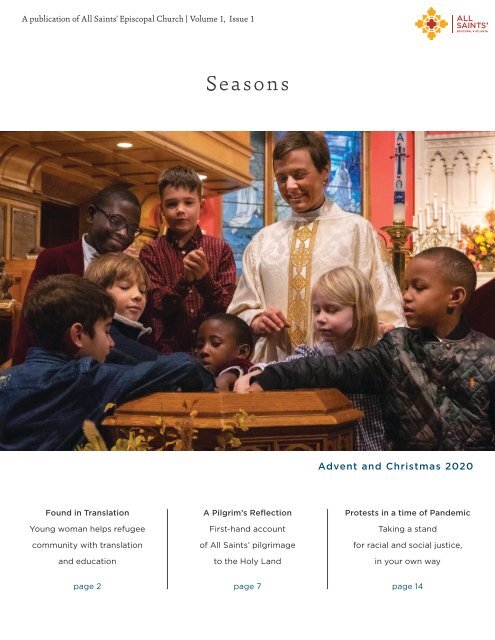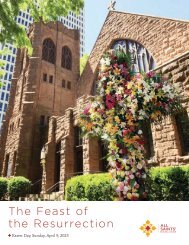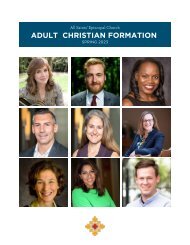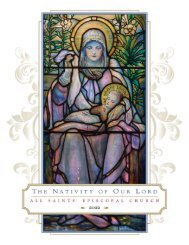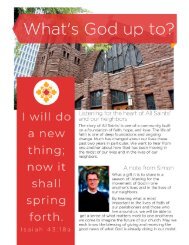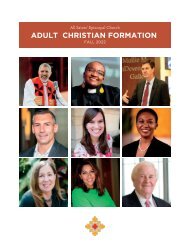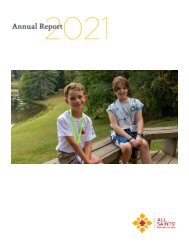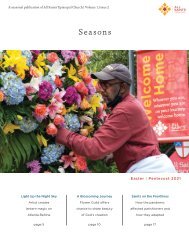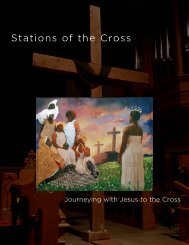Seasons Issue 1
- No tags were found...
Create successful ePaper yourself
Turn your PDF publications into a flip-book with our unique Google optimized e-Paper software.
A publication of All Saints’ Episcopal Church | Volume 1, <strong>Issue</strong> 1<br />
Advent and Christmas 2020<br />
Found in Translation<br />
Young woman helps refugee<br />
community with translation<br />
and education<br />
A Pilgrim’s Reflection<br />
First-hand account<br />
of All Saints’ pilgrimage<br />
to the Holy Land<br />
Protests in a time of Pandemic<br />
Taking a stand<br />
for racial and social justice,<br />
in your own way<br />
page 2<br />
page 7<br />
page 14
Welcome! 1<br />
The Rev. Dr. Simon J. Mainwaring<br />
Simon is rector of All Saints’ Episcopal Church.<br />
Found in Translation 2<br />
Louisa Merchant<br />
Louisa serves as the director of refugee ministries<br />
at All Saints’ Episcopal Church.<br />
This Buoyant and Abiding Faith 4<br />
The Rev. Sarah C. Stewart<br />
Sarah is associate rector for young adults and innovation.<br />
A Pilgrim’s Reflection 7<br />
Dwayne Summar<br />
Dwayne is former vice president of public relations<br />
at Southern Company.<br />
A publication of<br />
All Saints’ Episcopal Church<br />
Volume 1, <strong>Issue</strong> 1<br />
MANAGING EDITOR<br />
Justin Averette<br />
CREATIVE | DESIGN DIRECTOR<br />
Lisa Bell<br />
CONTRIBUTORS<br />
Lawrence Davidson<br />
Shannon Dobranski<br />
Stephen Dobranski<br />
Louisa Merchant<br />
The Rev. Zachary C. Nyein<br />
The Rev. Sarah C. Stewart<br />
Dwayne Summar<br />
Ivy Way<br />
PHOTOGRAPHY<br />
Lisa Bell<br />
Tom Rhodes<br />
Of God and Google 10<br />
The Rev. Zachary C. Nyein<br />
Zack serves as associate rector for community engagement<br />
and children and youth formation.<br />
On Being Human<br />
in the Face of a Pandemic 13<br />
Shannon and Stephen Dobranski<br />
Shannon is a faculty member and director in the Office<br />
of Undergraduate Studies at Georgia Tech.<br />
Stephen is a professor of literature at Georgia State University.<br />
Protests in a Time of Pandemic 14<br />
Ivy Holliman Way<br />
Ivy is a historian at Kennesaw State University.<br />
Profile: Martha Sterne 16<br />
Justin Averette<br />
Justin is senior communications specialist<br />
with Southern Company.<br />
Closing Reflection 17<br />
©2020 <strong>Seasons</strong>. All rights reserved.<br />
All material in this magazine may not be reproduced,<br />
transmitted or distributed in any form without the written<br />
permission of <strong>Seasons</strong>. Publication #10796.<br />
Postage paid at Atlanta, GA. ISSN #1073 – 6549<br />
All Saints’ Episcopal Church<br />
Atlanta, Georgia<br />
allsaintsatlanta.org
Have you ever been really thirsty? For much to all of my childhood growing up in<br />
middle England, I took water for granted. It came to me clean out of the faucet. I could<br />
drink it in an endless variety of ways, including of course – being English – as one<br />
form or other of tea. It never ran out, and I never imagined that it would. Then, at the<br />
age of 18, I had my first experience of living overseas for six months in northeast India.<br />
There, water was a precious and at times scarce thing. For my sensitive Western belly,<br />
it was not clean to drink from the faucet, and even if it were, many days when you<br />
turned the faucet nothing came out. Water was seasonal. In a monsoonal climate, life<br />
waits for the waters to come in their due season. During those seemingly endless weeks<br />
of dryness, it felt as if I was always thirsty. And then the rains came. In the hill region<br />
where we lived, streams would burst forth. Plant life would flourish and at last we<br />
would get relief from the summer heat.<br />
This inaugural edition of <strong>Seasons</strong>, our exciting new publication for All Saints’ comes<br />
to us in the midst of a dry season of our own. We are thirsty for what we also used<br />
to take for granted: eating in crowded restaurants with no care as to whether the person<br />
at the table nearby might be sick; kids in school and at play, and we in and out of one<br />
another’s lives with carefree ease; singing together, sharing bread and wine together,<br />
seeing each other face to face. It’s amazing just how much there is that we count on<br />
without even noticing that we do.<br />
It has taken a pandemic for society at large to notice the value of the everyday things<br />
and what we say is important about our lives. More personally, we can find that our<br />
thirst for what the New Testament calls “living waters” can be made known to us by<br />
the degree to which we choose to author the life we are living. Yes, we confess with joy<br />
and confidence that Christ Jesus is the wellspring of the waters that will quench our<br />
thirst for a life that is lived deeper than the surface level. Yet, much like the Samaritan<br />
woman who encounters Jesus at the well in John’s gospel (John 4:1–26), we have<br />
to make our movement toward the source in order to discover it.<br />
Reading the pieces written in this first edition of <strong>Seasons</strong>, I’m struck how each tells<br />
a story of that sort of movement to where living waters might be found. From pilgrims<br />
crossing the waters to the holy lands of Israel and Jordan, to youth and young adults<br />
stirring the waters as they strive for justice in our time, the sense of movement in body<br />
and heart is clear. As you’ll read, sometimes the movement toward one another requires<br />
the kind of tenacity that former refugees learn through long seasons of thirsting<br />
for mercy and hope, and sometimes a thirst for God is a life-long deepening of the soul<br />
as so many of us have witnessed in the life and leadership of Martha Sterne.<br />
Whatever your thirst might be right now, I pray that the pages of this beautiful publication<br />
will stir up those deeper pools that dwell within you for your own unique and<br />
wondrous human expression of life on this earth. Here’s to all<br />
the seasons we enjoy as this church, and to the great privilege<br />
we share in offering a cool drink to a thirsty world.<br />
Peace,<br />
The Rev. Dr. Simon J. Mainwaring, rector<br />
1
Found in Translation<br />
26-year-old helps refugee community<br />
with English translation and education<br />
from Louisa Merchant<br />
I met Paw Gaw in October 2018,<br />
when we were both sitting on<br />
the floor of Hartsfield-Jackson<br />
Atlanta International Airport –<br />
for seven hours. Paw had come<br />
to help out with Karen language<br />
interpretation for the arrival<br />
of our new Refugee Ministries<br />
family from Myanmar (Burma).<br />
A friend at our refugee agency had asked her<br />
to help us because he knew our new family<br />
didn’t speak any English. Because no one was<br />
permitted to meet the family at the gate, they<br />
got lost. Finally, at 1 a.m., the airport allowed<br />
Paw to go down to the lower levels by herself<br />
and find our new family.<br />
That was the beginning of a wonderful relationship<br />
of ministry. For example, when All Saints’<br />
provided Threads clothing and backpacks<br />
filled with school supplies to 136 children in<br />
Clarkston and Stone Mountain who, like all<br />
of us, were struggling with the isolations of<br />
COVID-19, some 20 of those families came<br />
to us through Paw Gaw. These same families<br />
also received an online tutor from All Saints’<br />
to help their children with schoolwork.<br />
Paw is 26 years old. She spends most days<br />
helping her community with English interpretation<br />
in everything from applying for food<br />
assistance to buying a car. When I asked Paw<br />
how she came to such an active ministry in her<br />
community, she said, “I would pray to God,<br />
‘Use me when you can, especially for the Karen<br />
people who face a lot because everything is new,<br />
and they need help’.”<br />
I had known Paw for a year before I realized that<br />
a story that I had been telling people for months<br />
was about her sister. Refugee Ministries works<br />
with families from Burma, Nepal and countries<br />
in Africa and the Middle East. We often don’t<br />
know what our families have been through so<br />
when I heard this story one night from the chair<br />
of our Refugee Ministries Advisory Board, Steve<br />
Heckler, he was opening my eyes to something<br />
for the first time.<br />
He told us about a young woman who had come<br />
to the U.S. from a refugee camp in Thailand<br />
and had decided to go back to this camp to visit<br />
when she was on a semester abroad from Agnes<br />
Scott College. When she approached the camp<br />
surrounded by barbed wire and armed guards,<br />
she was told that she only had 50 minutes<br />
inside or they would come and get her.<br />
When she entered the gate, she was immediately<br />
surrounded by families, crying and hugging her,<br />
because they remembered her as a child when her<br />
family lived in the camp for 11 years. She said<br />
that she could not get over the fact that during<br />
the decade that she had been gone, learned to<br />
speak English and had the opportunity to attend<br />
college, these families hadn’t been able to leave<br />
the prison walls of the refugee camp.<br />
Fewer than 1% of the more than 24 million<br />
people worldwide designated as refugees ever<br />
get to come to a third country like the U.S.,<br />
where they have the legal right to live, work<br />
and receive an education. This young woman<br />
was Meh Sod Paw, Paw’s sister.<br />
2
Paw Gaw (right) with her sister Med Sod Paw.<br />
Their mother named all her children Paw, which means flower in Karen.<br />
It turns out that both Meh Sod and Paw<br />
attended the Global Village Project, a school<br />
for former refugee girls located in Decatur.<br />
This amazing school was started in 2009<br />
by Barbara Thompson, founder of All Saints’<br />
Refugee Ministries, as well as by All Saints’<br />
parishioners Chris Burgess, Pamela Koperda,<br />
Kris Birkness and other community members.<br />
Kris Birkness states, “The school was founded<br />
to address the needs of teenage girls who experienced<br />
interrupted education from war. We<br />
needed to find a way to teach them what they<br />
needed to know to make it in public school.”<br />
Both Meh Sod and Paw Gaw can’t say enough<br />
about their experience at the GVP school. Paw<br />
says, “It felt like home. I started acting like<br />
myself again because it was so comfortable and<br />
because there were people you could trust.”<br />
Both sisters recognize the impact outstanding<br />
and empathetic education has had on their lives.<br />
Meh Sod plans to begin her master’s program in<br />
teaching next year thanks to a full scholarship.<br />
Paw Gaw, when she isn’t busy learning how to<br />
start a Karen grocery store in her community to<br />
help her family and friends, will help All Saints’<br />
connect Karen kids with online tutors. She says,<br />
“Navigating the online school system has been<br />
really hard because we have kids whose parents<br />
don’t speak English.” It’s an honor to know these<br />
amazing resilient young women, and it is an<br />
honor to learn from them how to give back.<br />
3
This Buoyant and Abiding Faith<br />
Saints traverse oceans<br />
from Caribbean roots to Midtown<br />
from the Rev. Sarah C. Stewart<br />
Just before the Psalmist observes, “There is<br />
a stream that makes glad the city of God,”<br />
the speaker watches mountains slip beneath<br />
the waves of a turbulent sea.<br />
Life’s tumult stirs our urge to seek refuge. Such<br />
havens evoke human rejoicing, even amid difficulty.<br />
Relief floods our bodies as we surrender<br />
to our source, the spirit who hovers over the<br />
whole creation with soothing whispers of love.<br />
Tales of an underground spring that nourishes<br />
our magnolia along West Peachtree Street are<br />
legendary. Less familiar, perhaps, are vignettes<br />
bearing witness to God’s grace, enlivening our<br />
community and our city through the presence<br />
of our Caribbean American siblings in Christ.<br />
Their companionship has inspired uplifting<br />
celebrations and enriched our shared lives<br />
with vibrant culture. Such spirited rejoicing<br />
echoes God’s own jubilation, whenever we share<br />
the living waters of our faith.<br />
Some saints have traversed oceans to make<br />
their home among our Midtown family.<br />
They grace us with reminders of the beauty<br />
of the global Anglican tradition, in which<br />
Episcopalians merge with other branches<br />
of the Jesus Movement in ways that stretch<br />
and bless us all. Hailing from islands where<br />
residents know firsthand the fragility of life<br />
upon this earth, “our island home,” these fellow<br />
Christians exude trust in God’s faithfulness.<br />
Confidence in God’s constant care flows from<br />
replenishing habits of prayer. Such precious<br />
resources, shared generously by Bahamian<br />
members of All Saints’, hold out hope amid<br />
global uncertainty. For many, life’s storms<br />
raged long before coronavirus.<br />
Lisa Gomez-Cantrell recalls her family<br />
relocation in the aftermath of Hurricane<br />
Katrina. A long-time friend, Tanya Mann,<br />
persuaded Gomez-Cantrell to choose Atlanta<br />
over Houston when departing New Orleans,<br />
where Gomez-Cantrell saved local neighbors<br />
from disaster before leaving town. It wasn’t until<br />
a priest stopped by the local wireless store in<br />
Midtown, where Gomez-Cantrell worked, that<br />
she discovered the spiritual hospitality that<br />
typifies our life together.<br />
All Saints’ liturgical sensibilities contrasted<br />
with high church worship at St. Agnes’ Nassau,<br />
where Gomez-Cantrell grew up and her grandfather<br />
served as Sunday school superintendent.<br />
That didn’t stop Lisa’s daughters from putting<br />
down roots. The girls quickly were singing<br />
in the choir, attending formation classes and<br />
serving as acolytes. Naming the magnetism<br />
that swept them into the fold, Lisa describes<br />
“the sense of connection that brings everyone<br />
back together with joy.”<br />
Another transplant, from Bimini, Tanya Mann<br />
also found herself delighted by the energy<br />
that drew in the Gomez-Cantrells. The Manns<br />
sacrificed to make the commute from Roswell<br />
to embrace the warmth of this communion.<br />
Vaughan Fountain cites his own spiritual<br />
upbringing – rooted in the same parish that<br />
shaped Gomez-Cantrell – as the reason he was<br />
drawn to All Saints’. Fountain visited diverse<br />
denominations as a young adult hungry for<br />
dynamic worship. When he and his wife Nadia<br />
began building their family, they looked for<br />
a faith community that prioritized prayer,<br />
gratitude and justice. For Vaughan, All Saints’<br />
4
Saints from around the globe joined in blessing Robin Saunders’ son, Ocean,<br />
during his baptism earlier this year.<br />
5
Atlanta Junkanoo Group performs at All Saints’ to raise money to help victims of Hurricane Dorian in 2019.<br />
The performances reflect traditional parades on Boxing Day and New Year’s Day that showcase months<br />
of creative design and artistic rehearsal.<br />
offered a unique context where individuals<br />
could know and be known, joining together to<br />
cultivate resilience and to live compassionately,<br />
in response to the needs of neighbors both<br />
local and global.<br />
Last year, after Hurricane Dorian ravaged the<br />
Bahamas, the Fountains galvanized All Saints’<br />
for a fundraiser to assist rebuilding efforts.<br />
Their ministry welcomed Midtown saints and<br />
friends to sample cuisine and music, performed<br />
by Vaughn’s own percussive Junkanoo band.<br />
Nadia’s faithful leadership in All Saints’ MICAH<br />
Project fosters spaces for reflection and healing<br />
through honest conversations around race.<br />
Virgin Islanders Joycelyn and Ethelred Martin<br />
have weathered decades of nature’s caprice. The<br />
couple celebrated 30 years “better together” this<br />
summer. Not even a year-long postponement<br />
of their wedding due to hurricane onslaught of<br />
their homeland could cancel their love. Joycelyn<br />
connects love’s power to stretch us on this spiritual<br />
journey, noting it can be easier to give than<br />
to receive love’s humble fruits. Recounting<br />
a season when her own health needed extra<br />
care, Joycelyn recalls how All Saints’ Befrienders<br />
Ministry helped her. These days she looks for<br />
ways to “bless people each day.”<br />
As president of Georgia’s Caribbean American<br />
Heritage Coalition, Joycelyn is indeed a blessing,<br />
relentlessly advocating for individuals<br />
and families throughout metropolitan Atlanta,<br />
supporting their efforts to secure naturalization<br />
as citizens, voting rights and healthcare.<br />
Seas do not always roar and foam, the Psalmist<br />
reveals. Robin Saunders cherishes the haven<br />
she knows in living waters, which even inspired<br />
her son’s name of Ocean. His 2019 baptism<br />
at All Saints’ gathered Anglicans from near and<br />
far, including Bahamian relatives. That glorious<br />
day magnified the Christ light that splashes<br />
across our city.<br />
Delighting in the refuge and refreshment<br />
we know through this wellspring of abundant<br />
life, we lift up thankful hearts to praise our<br />
loving Creator, whose faithfulness gladdens<br />
the whole creation!<br />
6
A Pilgrim’s Reflection<br />
First-hand account of All Saints’<br />
journey to the Holy Land<br />
from Dwayne Summar, photos from Tom Rhodes<br />
Tom Rhodes, the principal of a Dunwoody-based<br />
architectural firm, shares some of his most profound<br />
experiences from All Saints’ February pilgrimage<br />
to the Holy Land.<br />
For years, I had wanted to visit the Holy Land –<br />
but with someone who possessed a theological<br />
background and deep understanding of place<br />
rather than a tour guide, even a well-trained one.<br />
So, when my wife Kathi called me at the office<br />
and said Simon (Mainwaring, All Saints’ rector)<br />
was leading a pilgrimage to the Holy Land,<br />
my response was immediate – let’s go.<br />
Called “The Holy Land and<br />
Biblical Jordan,” the pilgrimage<br />
was Feb. 14–26, just prior<br />
to the pandemic. More than 40<br />
parishioners signed on. Simon<br />
had written in the brochure<br />
introduction: “As we travel<br />
together through Jerusalem, Cana, Nazareth,<br />
Galilee and Jordan, we will have the opportunity<br />
to visit sacred sites and to weave scripture,<br />
stories, lessons and the experiences of that part<br />
of the world into our own life stories.”<br />
Tom and<br />
Kathi Rhodes.<br />
Shabbat at Jerusalem’s massive Western Wall.<br />
7
There are many definitions of pilgrimage, yet my<br />
personal favorite is “to seek a close encounter<br />
with God.” Just one encounter would have been<br />
wonderful. But in retrospect, the glorious nature<br />
of this pilgrimage was experiencing numerous<br />
genuine God encounters.<br />
Top left: Magnificent Roman ruins abound.<br />
Bottom left: Via Dolorosa, the path on<br />
which Jesus bore the cross.<br />
Top right: Sunrise over the gentle waves<br />
of the Sea of Galilee.<br />
An early-on encounter came one morning while<br />
plying the gentle waves of the Sea of Galilee.<br />
Others included renewing our wedding vows<br />
in Cana where, of course, He was a guest!<br />
Renewing my baptism in the flooded Jordan<br />
River is a memory I shall carry always and<br />
surely He was present then too.<br />
There’s more … standing upon Mount Nebo<br />
overlooking the Promised Land produced<br />
goosebumps. Traversing the rustic steps of Via<br />
Dolorosa was life changing. Watching Kathi<br />
climb up onto the hump of an indignant camel<br />
in Petra – well perhaps not a God moment but<br />
certainly worth the cost of the airfare!<br />
8
A single most cherished memory? Experiencing<br />
Shabbat (the Jewish Sabbath) at sunset beneath<br />
the massive Western Wall in Jerusalem was so<br />
profoundly moving that Kathi and I continued<br />
to celebrate this ancient custom each Friday<br />
evening complete with a little menorah purchased<br />
in the Old City. The singing, the dancing<br />
and the sheer joy of the celebrants was exhilarating.<br />
It touched my heart deeply. I returned<br />
for the conclusion of Shabbat (the Havdalah<br />
ceremony) refusing to leave until seeing the first<br />
three stars appeared in a crystal blue sky above<br />
ancient blocks of tan-hued stones.<br />
In 2011, my father was on his way to Jerusalem<br />
with his church but fell gravely ill one month<br />
prior to departure. He never made the journey.<br />
We postponed our memorial service until his<br />
friends returned from that pilgrimage to join<br />
in our joyful celebration of my Dad’s wonderful<br />
life. Accordingly, I was a hot mess of emotion<br />
that evening during my visit to the wall amidst<br />
a light rain, but Jesus came along for the walk,<br />
reminded me I was well-loved and assured me<br />
that Dad was watching from above. Call me<br />
crazy, but this really happened. That’s a God<br />
encounter. From Celtic theology, this perfectly<br />
depicts an exceedingly rare “thin moment”<br />
where heaven and earth briefly touch.<br />
During our divine adventure, we were taught<br />
by a Jordanian guide, a Catholic guide born in<br />
Jerusalem, a Muslim scholar, a Jewish historian<br />
and Hosam Naoum, the Bishop-elect of the<br />
Episcopal Diocese of Jerusalem. Also, I learned<br />
more from a 10-minute cab ride in Jerusalem<br />
than from 20 years of watching the news back<br />
home. Each person spoke of the millennia of<br />
conflicts and tension, yet each one also spoke<br />
so eloquently of survival, of accommodation,<br />
of life and of perseverance. And they all<br />
expressed a deep yearning for that elusive<br />
thing called peace, ironically in the footsteps<br />
of the King of Peace.<br />
9
Of God and Google<br />
Baptism and mission<br />
in time of pandemic<br />
from the Rev. Zack Nyein<br />
After leaving the fundamentalist traditions<br />
of her upbringing and rediscovering faith<br />
as a young adult, Amy Stage struggled for years<br />
to find a church that resonated with her gracious<br />
and expanding experience of God. After nearly<br />
giving up, Amy found All Saints’ through a<br />
Google search in the first weeks of the pandemic<br />
and immediately knew her search was over.<br />
Amy had found her spiritual home.<br />
On Oct. 18, the 34-year-old was welcomed to<br />
the waters of baptism, amidst sacred grounds<br />
and urban sounds converging within Kennedy<br />
Courtyard – an “altar in the world,” to quote<br />
former All Saints’ priest, Barbara Brown Taylor.<br />
Due to the pandemic, the day of Amy’s baptism<br />
also marked her first time stepping foot onto<br />
All Saints’ campus or meeting any of its clergy<br />
and people in-person. Thankfully, this blind<br />
date with destiny could be described as “love<br />
at first sight.”<br />
A small group of saints showed up donning<br />
masks, with physical distance, to extend with<br />
gusto the customary greeting: “We receive you<br />
into the household of God. Confess the faith<br />
of Christ crucified, proclaim his resurrection<br />
and share with us in his eternal priesthood!”<br />
There was nothing “normal” about it, and yet<br />
for a moment, palpable joy pierced through.<br />
The Holy One was with us.<br />
10
Historically, the church has characterized<br />
baptism as the “rite of Christian initiation.”<br />
In it, we are claimed as children of the God<br />
who promises to be refuge, strength, and shield.<br />
Paradoxically, however, baptism does not<br />
permanently sequester us from the woes of the<br />
world. If baptism is initiation into Christ’s own<br />
Body, then it is initiation as much into sacrifice<br />
as security; as much into trouble as peace.<br />
Put simply, baptism calls us deeper into<br />
relationship with the people and places where<br />
Christ wills to be found – among the last<br />
and the least; with tax collectors, prostitutes,<br />
sinners, and saints who couldn’t be more<br />
different. Sinners and saints, just like us.<br />
The baptized life aims not to fortify our faith<br />
within four walls. Rather, it blurs the real and<br />
imagined borders that divide us – those between<br />
11
All Saints’ finds uniques ways to worship together while remaining safe,<br />
from outdoor services, baptisms, our annual animal blessing and more.<br />
self and neighbor, church and world, sacred<br />
and profane. If there has been any grace for the<br />
church in 2020, it has been in the<br />
opportunity to be more the church – the Body<br />
of Christ, constituted through baptism, gathered<br />
and scattered for the good of the world.<br />
All Saints’ has embraced this call in myriad<br />
new and creative ways during the pandemic.<br />
Through online worship, Zoom groups, coat<br />
collections, food drives, pet blessings, lantern<br />
parades, backyard weddings, and everyday acts<br />
of justice, mercy and love, the saints have taken<br />
to the city, where God has been at work all along.<br />
We will one day return to our beloved<br />
stone edifice, where we will gather<br />
again at God’s table to feast on Christ’s<br />
Body and Blood. Until then, we make<br />
our altar in the world, as we continue<br />
to baptize, alongside Amy, all who<br />
would join us in faith lived out where<br />
sanctuary meets street. Until then,<br />
we remain Christ’s risen Body – living<br />
stones for a world that hungers, thirsts<br />
and even Googles after the God who<br />
lives in us. For, “out of the believer’s<br />
heart shall flow rivers of living water”<br />
(John 7:38).<br />
Nothing about it is normal.<br />
Still, the Holy One is with us.<br />
Upper left: Sacred space has made outdoors for worshippers ready to return<br />
to campus safely during this time of pandemic.<br />
Lower right: The Rev. Dr. Andrew Barnett blesses one of many pets who attended our annual<br />
Blessing of the Animals, this year held in a Georgia World Congress Center parking lot.<br />
12
On being human<br />
in the face of a pandemic<br />
from Shannon and Stephen Dobranski<br />
How do you live your faith in a time of pandemic?<br />
How can you serve others while struggling<br />
with your own doubt and anxiety? These are<br />
questions all of us must answer during these<br />
unprecedented times.<br />
Healthcare professionals, of course, have<br />
a special burden in dealing with the strain and<br />
stress caused by COVID-19.<br />
Joe Bresee is a member of All Saints’ and<br />
associate director for global health at the<br />
Centers for Disease Control and Prevention<br />
(CDC). In normal times, he directs the influenza<br />
division. But since late January, Joe has been<br />
serving as deputy incident manager of the<br />
national response to the coronavirus. It’s a job<br />
he volunteered for hoping to draw on his years<br />
of experience with other outbreaks.<br />
So far, Joe has found COVID–19 to be not much<br />
different from other contagious diseases he has<br />
worked on like SARS. However, the response<br />
to this global health threat, like others, requires<br />
a community of committed professionals who<br />
lean on each other as they serve a larger cause.<br />
Joe feels fortunate to work alongside people who<br />
“have been amazingly dedicated and have kept<br />
the focus on mission and science throughout,<br />
putting in long days and weeks away from their<br />
families and friends – in service.”<br />
In 2003, Joe was far from home,<br />
in Hong Kong, working on the<br />
SARS outbreak. Late one night, missing<br />
his wife and young<br />
children, he returned to his hotel<br />
room and listened to that week’s<br />
sermon online.<br />
All Saints’ then rector, Geoffrey<br />
Hoare, had focused on “precious<br />
gifts, freely given,” a message<br />
that continues to help Joe during<br />
the current crisis.<br />
“What resonated with me, then and now,” he<br />
says, “is the central idea that giving is a blessing,<br />
especially giving that which is most precious.<br />
In that case, and now, one thing that I am able<br />
to give is time or work in service to the goals<br />
of reducing the impact or risk from this virus.<br />
The cost, then and now, is time away from<br />
family and is precious.”<br />
Joe’s advice for all of us as we seek a path<br />
forward is to embrace our own community.<br />
“It sounds trite,” he says, “but recognize that<br />
the uncertainty and fear that the pandemic<br />
necessarily generates is felt by everyone.<br />
Amidst the pressures to isolate or retreat, find<br />
ways to connect with others to talk and spend<br />
time with them as an antidote to the anxiety<br />
that the daily news might bring.”<br />
Joe Bresee,<br />
All Saints’<br />
parishioner<br />
and associate<br />
director for<br />
global health,<br />
Centers for<br />
Disease Control<br />
and Prevention.<br />
13
Protests in a time of pandemic<br />
Taking a stand for justice,<br />
in your own way<br />
from Ivy Holliman Way<br />
“Let justice roll down like water, and righteousness like a mighty stream!” (Amos 5:24)<br />
14<br />
Atlanta has long<br />
wanted to be seen<br />
as “the city too<br />
busy to hate,” but<br />
she’s no stranger to<br />
racial tension. In<br />
September 1906,<br />
Atlanta witnessed a<br />
heated gubernatorial<br />
campaign between<br />
Clark Howell, editor/<br />
owner of the Atlanta<br />
Constitution, and<br />
Hoke Smith, one –<br />
time owner of the<br />
Atlanta Journal. Back then, the question of disenfranchising<br />
Black Georgians was a top issue.<br />
Both candidates used race-baiting in their<br />
papers, specifically, the fear of Black male<br />
violence against white women to ensure that<br />
white men took to the polls and elected the<br />
candidate most likely to end the Black vote.<br />
In the aftermath, Jim Crow segregation took<br />
firm hold in Atlanta, and the Black vote largely<br />
ended for the half-century.<br />
Fast-forward half a century to September 1966.<br />
Atlanta was not “Bombingham,” but it experienced<br />
racial tensions during the civil rights era<br />
too, even if the national press paid much less<br />
attention. Interstate construction and urban<br />
renewal had engendered mistrust between<br />
working class Black Atlanta neighborhoods,<br />
city government and business elites.<br />
In the summer of 1966, Summerhill residents<br />
staged a traffic-stopping football game on<br />
Capitol Avenue to protest the fact that the city<br />
had not fulfilled its promise to build a neighborhood<br />
playground. By September, when Atlanta<br />
police pulled over and shot a Black man on<br />
suspicion of auto theft, Summerhill residents<br />
and community organizers were fed up.<br />
In response, the Student Non-Violent<br />
Coordinating Committee called demonstrators<br />
to protest racist treatment from the city. Mayor<br />
Ivan Allen dodged flying bricks and bottles<br />
as he tried to calm down demonstrators.<br />
The Summerhill riot cemented the idea that<br />
poor Black residents in downtown Atlanta<br />
felt that the city power structure was not representing<br />
their best interests, and this mistrust<br />
would continue through subsequent waves<br />
of downtown redevelopment.<br />
May 2020, 10 weeks after the COVID-19<br />
shutdown began in Georgia:<br />
On the weekend after Memorial Day, Mayor<br />
Keisha Lance Bottoms sent a text message<br />
announcing a city-wide curfew. She wanted<br />
to prevent possible violence downtown.<br />
Americans were reeling from the death of a<br />
Black man named George Floyd. During a traffic<br />
stop on May 25, a police officer in Minneapolis<br />
pinned Floyd down on the ground with his knee<br />
for eight minutes and 46 seconds, suffocating<br />
him. We know 8:46 because of leaked video<br />
recordings of the event that made their way onto<br />
every social media platform and broadcast news<br />
network. Floyd’s death, sadly, was not unusual.<br />
That his death prompted nationwide protests<br />
in the midst of a global pandemic was. Black<br />
Americans were willing to risk infection from<br />
the novel coronavirus to take to the streets<br />
to say again, “Black Lives Matter!”
In Atlanta, protests over Floyd’s death centered<br />
on Centennial Olympic Park and the adjacent<br />
CNN Center, the closest thing we still have to<br />
a town square or city center. People were and<br />
are angry enough about racism that they are<br />
literally risking their lives twice over – risking<br />
violence at the demonstrations, either from<br />
police or from fellow demonstrators, and risking<br />
infection from COVID-19, being in close proximity<br />
with other protestors, some of whom were<br />
not wearing masks.<br />
I was torn. I knew all too well why people<br />
were protesting, and I wanted to participate.<br />
I also felt guilty about of my own white privilege.<br />
My entire life, I have had access to better<br />
schools because of the color of my skin. My<br />
schooling has opened up networks, interviews,<br />
opportunities, jobs and economic security.<br />
I know the playing field is not level – I owe my<br />
successes in part to the advantages that my skin<br />
color has afforded me. But would my being there<br />
help? What if I got injured? What if I got sick?<br />
Spoiler alert: I did not go out to protest. I did<br />
not march after Floyd’s death, nor did I take<br />
to the streets two weeks later, after police killed<br />
Rayshard Brooks at a Wendy’s on University<br />
Avenue. I did not stand at the candlelight vigil<br />
memorializing John Lewis’ death. But…<br />
I am protesting. I am playing to my strengths.<br />
I am teaching.<br />
I teach about 400 college undergraduates every<br />
academic year. I have always approached the<br />
Introduction to U.S. History with a missionary’s<br />
zeal, impressing upon students how and<br />
why history matters. But this semester more<br />
than ever, I want students to understand that<br />
before we can say history matters, we must first<br />
acknowledge that Black Lives Matter.<br />
Our nation’s history is complicated in part<br />
because we have had people in power that<br />
have denied the humanity of Blacks’ lives. Our<br />
nation’s story becomes richer when we place<br />
greater emphasis on underrepresented voices,<br />
multiple perspectives, and it means sometimes<br />
coming to terms with conflicting sources.<br />
I want students to develop empathy toward<br />
people within their historical context, particularly<br />
where it differs from their own contexts.<br />
I am not indoctrinating anyone to a particular<br />
ideology. I want students to think about how<br />
competing notions of liberty and justice over<br />
time have led to changing ideas about what<br />
the federal government should do and whom<br />
it should serve. My protest lies in re-engaging<br />
students with the idea of the public good and<br />
democratic ideals.<br />
Page 14:<br />
Whitney<br />
Grimes and<br />
coworker.<br />
Page 15, top:<br />
Grace Osborn<br />
and friends.<br />
Page 15,<br />
bottom:<br />
Paul Frilingos.<br />
15
The Rev. Martha Sterne grew up in Jackson, Mississippi, an eighth<br />
generation Mississippian. Born in 1947, her high school was integrated<br />
her senior year, leaving a lasting impression on her.<br />
“Six brave souls came to this high school with a total student population<br />
of 1,800. That caught my attention. I don’t know that I could have done<br />
that,” Sterne said.<br />
Martha Sterne<br />
Profile on a Saint<br />
from Justin Averette<br />
After high school, her parents wanted her to expand her horizons, sending<br />
her to Vanderbilt University, where she met her husband of 50 years,<br />
Carroll. The couple lived in Atlanta most of those five decades, raising<br />
their children here.<br />
Sterne was raised Presbyterian but came to the Episcopal Church<br />
after operating an employment project at Perry Homes mixed-income<br />
community. She grew frustrated she couldn’t help the families in the<br />
community more.<br />
“I had been working with the employment program three or four years,<br />
connecting people to low paying jobs and not really doing anything<br />
about their need for childcare,” Sterne said. “I went to seminary after<br />
that when I figured out, I don’t know what I’m doing, and I want to think<br />
about that a lot more.”<br />
She started with All Saints’ right out of Candler School of Theology<br />
in 1988. She thinks she was recruited in part due to her involvement<br />
with the project at Perry Homes and other work around racial justice.<br />
“That’s what I did at All Saints’. I was their outreach person, and we<br />
were doing a bunch of good things, some of which I inherited and some<br />
of which I helped start,” Sterne said.<br />
That work over the next 10 years included helping at-risk<br />
youth finish their education, a night shelter that eventually evolved<br />
to Covenant Community, refugee outreach and AIDS ministries.<br />
“I never did anything at All Saints’ that wasn’t covered up<br />
by the brains and heart of All Saints’ parishioners. All I did was<br />
get myself in the middle of people who were thinking and willing<br />
to work on something that could reach out into the world.”<br />
After All Saints’, Sterne was rector of St. Andrew’s in Maryville,<br />
Tennessee, for 10 years before returning to Atlanta to be nearer to<br />
children and grandchildren. She took a job as associate rector of Holy<br />
Innocents in Sandy Springs and has written two books (Alive and Loose<br />
in the Ordinary and Earthly Good) on helping people pay attention<br />
to the living presence of God in us and in all our days.<br />
16
Water. The source of life on this fragile earth,<br />
our island home. We think of Jesus as our source<br />
of living water. And He is life-sustaining. He tells<br />
the Samaritan woman at the well that he can give her<br />
water that once she drinks of it, she will never thirst<br />
again. Elsewhere in the Gospels, Jesus tells<br />
followers that, “If anyone is thirsty let him come<br />
to me and drink. He who believes in Me, as the<br />
Scriptures said, ‘From his innermost being will flow<br />
rivers of living water.’” This water, in the form of the<br />
Holy Spirit, flows through all God’s children. We can<br />
share this water by being slower to judge and quicker<br />
to help, by talking less and listening more. How<br />
might we share our eternal spring with a parched<br />
world thirsty for hope and healing? For in sharing<br />
this water with others, we ourselves are renewed.
Join us for worship online this Christmas.<br />
Christmas Eve, Thursday, December 24<br />
A Christmas Liturgy of the Word with Children’s Pageant, 4:00 p.m. A Festival of Nine Lessons and Carols, 8:00 p.m.<br />
Christmas Day, Friday, December 25 Morning Prayer for Christmas Day, 10:00 a.m.<br />
Services will be broadcast on Facebook and Vimeo. Find us online at allsaintsatlanta.org.<br />
For the most current announcements on upcoming events, service opportunities, and worship services, please visit<br />
allsaintsatlanta.org/sunday-announcements.<br />
634 West Peachtree Street NW | Atlanta, Georgia 30308-1925<br />
telephone: 404.881.0835 | facsimile: 404.881.3796<br />
allsaintsatlanta.org


